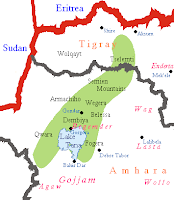According to tradition, the Jews rebelled against the Christians and established an independent state in the Semien Mountains, but there is no evidence to support this. There are other traditions. One of them is that a Jewish queen named Judith made an alliance with some pagans, the Agaw, and invaded Aksum's capital city, destroying churches and monasteries. Again, there is no evidence for this.
A 9th-century Jewish merchant and traveler, Eldad ha-Dani (c.851 - 900), claimed one of the 12 Tribes of Israel, the Tribe of Dan, went down the Nile and established themselves in Ethiopia. An Ethiopian Jewish community is also mentioned by both Marco Polo and Benjamin of Tudela.
The earliest recorded reference is found in the chronicles of Emperor Amda Seyon of Ethiopia, who sent troops to Semien to deal with unrest among Jews "and others." Ethiopian history and Beta Israel tradition both agree that Emperor Yeshaq (1414 - 1429) exerted pressure on Jews in Ethiopia. After the Jews rebelled against this, Yeshaq divided them into three regions with commissioners to watch over them. Jews were told to convert or lose their lands, and they were given second-class status below Christians.
Separated from Israel, Ethiopian Jews were different from the Middle Eastern brethren. A letter in 1435 by a Jewish traveler, Elijah of Ferrara, to his family tells of meeting an Ethiopian Jew. He recounts that they do not celebrate Hannukah, did not know the Talmud, and followed the Oral Torah, passed down through the generations orally.
The history of the Beta Israel had many twists and turns, and we will look at more tomorrow.

.jpg)


